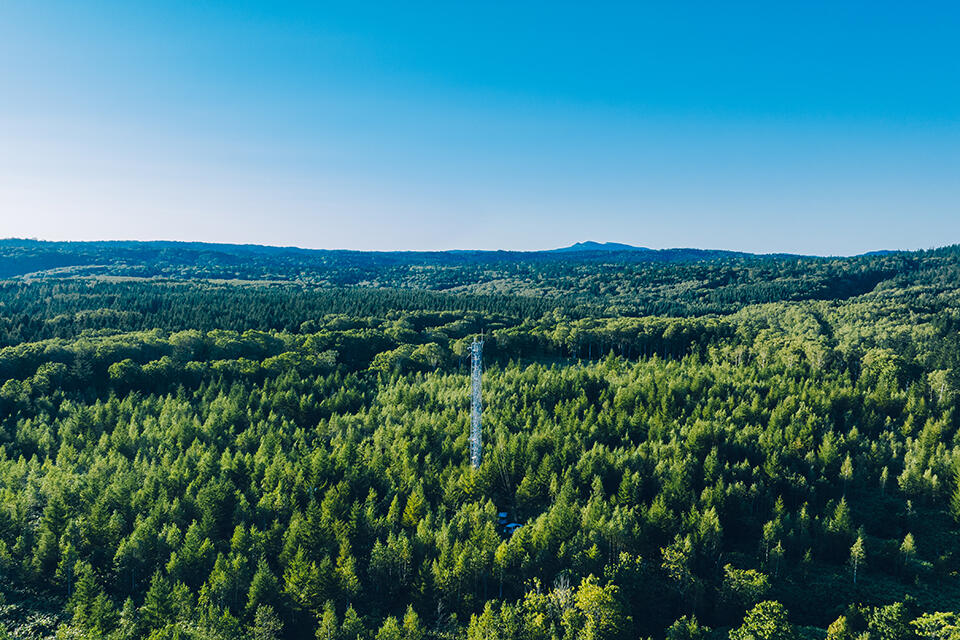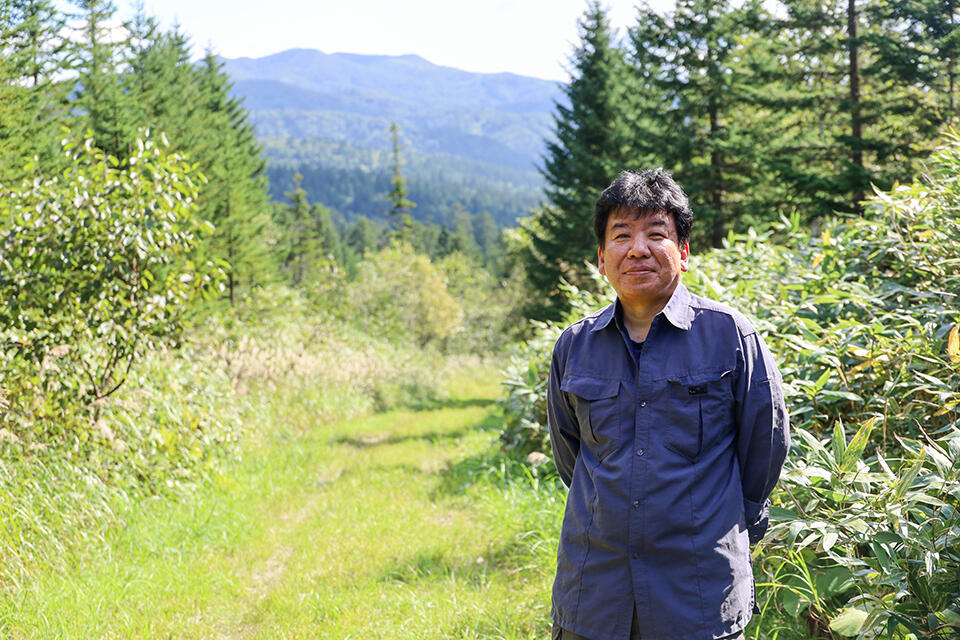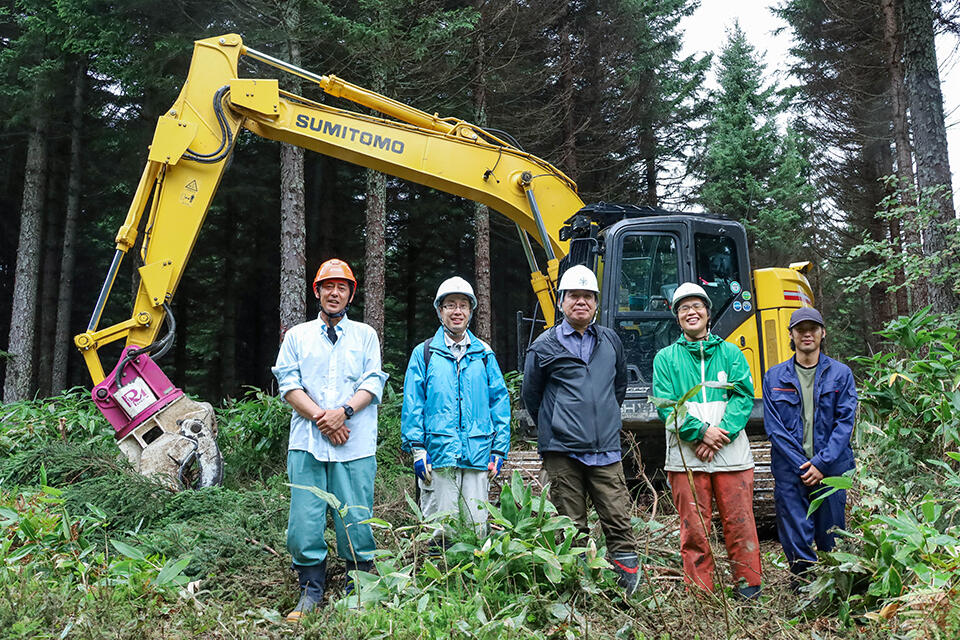Hokkaido University's research and academic facilities extend throughout Hokkaido and to Wakayama Prefecture,including Experiment Farms and Livestock Farm, extensive research forests, training ships, and aquatic research stations. With a total area of about 70,000 hectares, the research forests are among the largest in the world. The "Fields of Knowledge" series focuses on the diverse research and academic activities taking place in the fields.
Located in Horonobe Town in Hokkaido, a five-hour drive north of the Sapporo campus, the Teshio Experimental Forest is the northernmost university research forest in Japan, which has been protecting and nurturing a diverse range of forests-from primeval forests to plantations-for more than 110 years since its establishment in 1912. In the eighth installment of the 'Field of Knowledge' series, we introduce the Teshio Experimental Forest, featuring the voices of its researchers, students, and staff members.

An aerial view of the Teshio Experimental Forest with the observation tower in its middle. (Photo by GEOGRAMS)
Expansive and diverse forests
The Teshio Research Forest covers an area of approximately 22,500 ha, which is equivalent to about 4,800 Tokyo Domes. Together with the neighboring Nakagawa and Uryu Research Forests, they are known as the "Three Forests of the North," with a total area of more than 60,000 ha. It is one of the largest research forests owned by a single university in the world. The Teshio Experimental Forest is home to many wild animals and fish (e.g. Ezo brown bear, Steller's sea eagle, Japanese huchen, cherry salmon, etc.) as well as endemic plants like the Teshio cherry. The forest draws the attention of researchers across fields, including ecology, geology, and forest science. The natural environment is also used for practical training not only by Hokkaido University but also by students from all over Japan and abroad.

Professor Kentaro Takagi, the director of Teshio Experimental Forest, Field Science Center for Northern Biosphere.
Large-scale, long-term observation of carbon cycles
Large-scale, long-term field experiments are conducted in the Teshio Experimental Forest which has extensive grounds, heavy machinery and technical staff. One of these experiments is the 'Observational Research on the Carbon Cycle Function of Forests'. This has been ongoing since 2001 to clarify the effects of human intervention on the forest's ability to absorb carbon dioxide. 13.7 ha of its natural forest was logged, followed by the planting of approximately 30,000 seedlings, and long-term observations have been carried out on how CO2 absorption changes through the processes of deforestation, planting and reforestation. The project is still ongoing today.
"Logging transforms forests from carbon sinks to carbon sources. That's because after the cut-down trees are exported out from the ecosystem as timbers, the residues are also invisibly decomposing and emitting CO2 into the atmosphere at an ever-increasing rate. We found that it took 18 years to recover all the CO2 released into the atmosphere by the logging," explained Prof. Takagi.
Timber production and forest management
In the Teshio Experimental Forest, where timber production as well as education and research are carried out, technical staff play an active role in forest management. While the forestry industry as a whole is facing a shortage of staff, here the young employees are keeping up, supported by other staff. Yurika Yamamoto has been working at the Teshio Experimental Forest for three years after being introduced by her high school teacher.
She said, "As someone who works in the mountains, I want to become a full-fledged forestry worker by learning chainsaw skills and how to properly operate machinery. I am very interested in the researchers' and students' ideas on what they would like to do in the forests. I would like to support them as much as I can."
The Northern Forestry Research and Development Office of the Field Science Center for Northern Biosphere (FSC), Hokkaido University, to which the Teshio Experimental Forest belongs, introduced several high-performance forestry machines in 2020. This has resulted in an overwhelming improvement in the efficiency of operations in the cutting down and accumulating standing timber.
"We used to fell trees with chainsaws and gather them with bulldozers and other equipment, but by installing high-performance forestry machinery, the work can now proceed 1.5 to 2 times faster," said Tatsuya Fujita, a technical staff at the Teshio Experimental Forest.

Several of Teshio Experimental Forest's staff members in front of a feller buncher, a machine to cut down and accumulate standing trees for timber. Prof. Takagi is standing in the center. Second from right is Tatsuya Fujita, a technical staff.
A research ground for graduate school students
We spoke to some graduate students who are doing research in the Teshio Experimental Forest. Ruiqi Ma (M2, Graduate School of Environmental Science) is investigating how the amount of CO2 released from the soil due to microbial activity and root respiration changes under the influence of global warming.
"This year we are also doing an experiment on the stopping of global warming intending to see what changes would occur if global warming were to stop. In the future, I want to work as a forest scientist, so I'm doing my best,' said Ma.
Rihito Hosoda (M1, Graduate School of Environmental Science) uses ground and airborne observation data to study forest biomass and carbon stocks in the entire Teshio Experimental Forest. He had previously stayed in Okinawa for his undergraduate studies. "I came to Hokkaido University looking for a place where I could do research connected to my undergraduate research. I was attracted by the fact that I could do research on a fairly large scale in the northernmost research forest. In the old forests, there are many tall and thick trees and I found them to be different from the forests in Okinawa. Here, everything is big after all,' said Hosoda, describing the characteristics of the Teshio Experimental Forest.
A research ground for the Brown Bear Research Group
The student-led 'Hokkaido University Brown Bear Research Group' also benefits the Teshio Experimental Forest for their research field where the group has been conducting brown bear population surveys for more than 40 years since 1975. In August 2021, the group published an academic paper on the analysis of 40 years' worth of brown bear tracks (feces and footprints) data, led by a former member of the research group.
Taiga Yamamoto (B2, School of Law), representing the research group said, "Hokkaido University offers many activities that can bring you into contact with nature. That said, I don't think there are many clubs that go into nature and chase wild animals as much as the Brown Bear Research Group does. If there is anyone who is interested, I would be happy if you join Hokkaido University and our group."
Another member of the group, Hironori Mieda (M2, Graduate School of Environmental Science), further elaborated the strength of the Brown Bear Research Group. "In mammalian research, long-term data with a 50-year history is surprisingly rare. Like citizen scientists, what we do is only walking through the mountains and finding animal traces, but I think it's great that it can produce a larger body of scientific data from that. The fieldwork experience I have gained from joining the research group has been very useful for my own master's research."
The future of Teshio Experimental Forest
"The Teshio Experimental Forest offers an environment where students can engage in research by maximizing the use of their five senses in a diverse, natural environment," said Professor Takagi. "As a center for human resource development in field research, the facilities of Field Science Center for Northern Biosphere have been used for many years by a range of students. We hope that many more vigorous students will make use of the Center," added Prof. Takagi with high hopes.
Despite the harsh natural environment, the Teshio Experimental Forest attracts many researchers and students. They shall continue to deliver new discoveries from the northern forest to the world.
Originally written in Japanese by Manami Kawamoto (Office of PR & Comms.)
Photos by Nagao Miho (Public Relations Department)
Translated by Aprilia Agatha Gunawan (Office of PR & Comms.)
Interview for the video and article was recorded in September 2023.

















